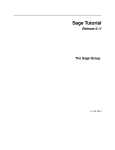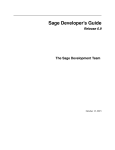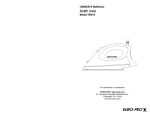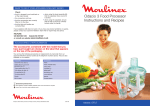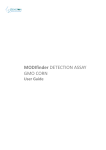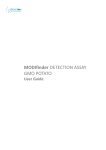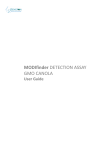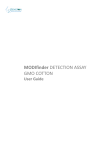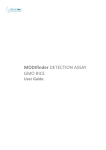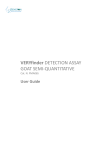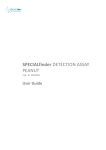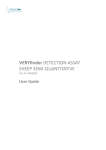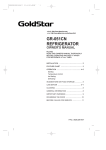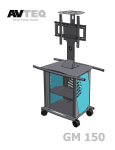Download User Guide
Transcript
ION FORCE DNA EXTRACTOR FAST Cat. N. EXD001 User Guide Rev 32 of 06/08/15 1 - Introduction ION Force FAST is a DNA extraction kit developed to fulfil the demands of the molecular biologist working in the food and feed field. This kit has a very flexible protocol that allows DNA recovery from a wide range of matrices. In this user manual protocols covering the majority of the applications are reported. Products available Part number EXD001 Ion Force DNA Extractor kit 100 rx EXD003 Ion Force DNA Extractor SOLUTION A (2000 ml) EXD004 Ion Force DNA Extractor SOLUTION D (150 ml) EXD005 Ion Force DNA Extractor BUFFER T (750 ml) EXD006 Ion Force DNA Extractor BUFFER P (50 ml) EXD007 Ion Force DNA Extractor COLUMNS EXD010-A Adapters for BOX VACUUM pack 12 EXD010-P DNA Extraction BOX VACUUM - Plastic User guide – Ion Force DNA Extractor FAST - Rev 32 of 06/08/15 2 2 – Ion Force DNA Extractor FAST 2.1 – Kit Content The kit (100 test) contains the following reagents: Product Quantity Solution A 4 x 500 ml Purification Solution 1 x 100 ml Columns 100 pcs Collection Tubes 100 pcs Buffer T 3 x 250 ml Buffer P concentrate 1 x 50 ml Solution D 1 x 20 ml Buffer P concentrate should be diluted by adding 200 ml absolute ethanol to obtain 250 ml of ready to use solution. Label the bottle after adding. 2.2 - Storage & Expiry information Expiry date: see date on the packaging, product validity refers to the product kept intact in its original packaging. Store at room temperature. Do not freeze the reagents or refrigerate below 8°C. 2.3 – Warranty and responsibility Generon s.r.l. guarantees the buyer exclusively concerning the quality of reagents and of the components used to produce the kit. In case of defective products Generon s.r.l. will replace it with a new one. Generon s.r.l. is not responsible and cannot anyway be considered responsible or jointly responsible for possible damages resulting from the utilization of the product by the user. User guide – Ion Force DNA Extractor FAST - Rev 32 of 06/08/15 3 3 – Materials and equipments needed Material/Equipment Source Chemicals: n-esane Lab Suppliers Tubes, 50 ml and 15 ml Generon or other Lab Suppliers Adapters for columns and syringes (EXD010-A) Generon or other Lab Suppliers Plastic spoons Generon or other Lab Suppliers Technical balance or similar, sensitivity: 0.01 g Generon or other Lab Suppliers 10 ml syringes, without needle, and cellulose acetate filters, 0.45 μm pore size Generon or other Lab Suppliers Graduated cilinder, 50 ml Generon or other Lab Suppliers Moulinex homogenizer or equivalent Generon or other Lab Suppliers Centrifuge with rotors for 1.5-2 ml microtubes and 50 ml tubes (range within 100–11200 x g (or rcf) Generon or other Lab Suppliers Thermal Water Bath or Block heated up to 85°C ± 2°C Generon or other Lab Suppliers Pipette sets Generon or other Lab Suppliers Pipette tips (Barrier) Generon or other Lab Suppliers Tube rack for 1.5 ml tubes Generon or other Lab Suppliers 2.0 and 1.5 ml micro-tubes Generon or other Lab Suppliers DNA Extraction VACUUM BOX + Vacuum pump or Venturi meter Generon or other Lab Suppliers Each step of sample preparation (grinding, transferring, weighing, etc.) must be done according to GLP so that chance of cross-contamination between samples is minimized. It is recommended to use disposable equipment when possible. If the food samples are not in a powdered or granular form, they should be processed (grinded or blended) before DNA extraction. The majority of DNA extraction methods supports from 20 to 50 mg of starting material. ION Force DNA Extractor FAST allows processing up to 20 grams of starting material in order to maximize sample’s lot representation. Once the sample has been pulverized/homogenized, it can be weighed and the appropriate amount extracted according to DNA extraction method selected. Refer to manufacturer user manual for extraction procedure details. User guide – Ion Force DNA Extractor FAST - Rev 32 of 06/08/15 4 4 – DNA Extraction from Food and Feed (1) Grind and/or homogenize the sample. Transfer into a 50 ml tube the requested quantity as indicated in Table 1 Matrix Weight (± 0.2 g) Aliquot of supernatant Filtration Flour and corn seeds Wheat flour Flour and soy seeds Generon “SpyX” products Seeds Milk powder Soy proteins, blood, meat flour Modified starch Lecithin granular and fluid * Glucose syrup and fruit juice Creams Chocolate creams, coffee Products soy based Corn flakes and honey Crackers, "grissini«, bran, polenta Animal feed Starches and sugars Raw and refined oils Pudding, mustard, jelly Lyophilized products, cheese Spices and dried vegetables Pizza Sweets, candy fruit Ready-to-use cake mixes Jam Tomato concentrate Baby food Vegetable matrices Flours and feed formulations Cooked Meat, fish and byproducts Rice and derivatives Margarine and butter Vitamin and mineral supplements Pet food, yeast and ferments Gastronomic specialities and Ice creams Sauces and dips Pasta Chips, snacks and biscuits Gluten and sweet corn flavours Sorbitol and maltitol Nougat and dried fruit 5.0 g 2.0 g 0.5 g 5.0 g 2.5 g 5.0 g 2.5 g 2.5 g 10.0 g 5.0 g 5.0 g 5.0 g 5.0 g 5.0 g 5.0 g 2.5 g 5.0 g 20.0 g 5.0 g 2.5 g 2.5 g 5.0 g 5.0 g 5.0 g 5.0 g 5.0 g 5.0 g 2.5 g 5.0 g 5.0 g 5.0 g 5.0 g 5.0 g 5.0 g 5.0 g 5.0 g 2.0 g 5.0 g 2.5 g 5.0 g 5.0 g 5.0 g 0.5 ml 0.5 ml 1.0 ml 0.5 ml 0.5 ml 0.5 ml 1.0 ml 2.5 ml 2.5 ml 2.5 ml 2.5 ml 1.0 ml 1.0 ml 0.5 ml 0.5 ml 0.5 ml 2.5 ml 2.5 ml 2.5 ml 1.0 ml 2.5 ml 1.0 ml 2.5 ml 2.5 ml 1.0 ml 2.5 ml 2.5 ml 0.5 ml 0.5 ml 0.5 ml 1.0 ml 2.5 ml 0.5 ml 0.5 ml 1.0 ml 2.5 ml 0.5 ml 2.5 ml 1.0 ml 2.5 ml 2.5 ml 1.0 ml No Yes Yes No Yes Yes Yes No No No No Yes Yes No No Yes No No Yes Yes Yes Yes Yes Yes Yes Yes Yes No Yes No Yes Yes Yes No Yes Yes No Yes No Yes No Yes Table 1: suggested weights for sample extraction, supernatant aliquots to be collected and filtration requirements for subsequent purification step. Weights reported are only indicative; for matrices with low DNA content it is possible to increase the starting quantity in order to obtain a more effective extraction. *for fluid and granular lecithin add to the sample 20 ml of n-Hexane. Shake gently and carefully avoid to turn the container upside-down, then add 10 ml of Solution A. Again, shake gently and leave it to rest for 10 minutes. Proceed according to the step 4.2 of this protocol but the sample is processed at room temperature instead of 85°C. User guide – Ion Force DNA Extractor FAST - Rev 32 of 06/08/15 5 4 – DNA Extraction from Food and Feed (2) 4.1 Add 20 ml of Solution A to the sample and then shake to homogenize the content. 4.2 Incubate 1 hour at 85°C ± 2°C, shake 2-3 times during the incubation period. 4.3 Centrifuge the sample at speed between 6000 and 10000 x g for 10 minutes (to convert g into rpm see instruction manual of your own centrifuge). 4.4 Transfer 1 ml of upper aqueous phase to a 2 ml tube. For the matrices reported in RED in Table 1, it is suggested to split 3 ml of upper aqueous phase into 3 individual 2 ml tubes. (Note: the upper phase is aqueous, in samples containing fats or oils the aqueous phase lies in the intermediate phase). 4.5 Add 0.8 ml of Purification Solution and shake vigorously 1 minute, then centrifuge the sample between 10000 and 11000 x g for 5 minutes. (Note: the supernatant must be clear. If not, repeat the centrifugal step). Proceed to the section 6 of this protocol. User guide – Ion Force DNA Extractor FAST - Rev 32 of 06/08/15 6 5 – Specific DNA extraction from particular matrix 5.1 Transfer into a 15 or 50 ml tube the requested quantity as indicated in Table 2 Matrix Weight (± 0.2 g o ml) Solution A Incubation time Aqueous phase to be transferred Purification Solution Aliquot of supernatant Animal Milk1 50 ml 5 ml 60 min Enrichment media 1 ml 9 ml 15 min 4 ml 4 ml 3.5 ml 1 ml 0.8 ml 0.9 ml Filters, swabs 1 unit 20 ml 15 min Not necessary Not necessary 1 ml Wine and beverages 8 ml 2 ml 30 min 4.5 ml 1.5 ml 3 ml Feathers and plumes2 2 units 1 ml 60 min 1 ml 0.8 ml Raw meat 5g 20 ml 30 min 1 ml 0.8 ml 0,5 ml Blood 1 ml 9 ml 15 min 1 ml 0.8 ml 0.9 ml 0.5 ml Table 2: for these matrices, a filtration step is not necessary. 1 centrifuge between 6000 and 10000 x g for 20 minutes and remove the supernatant made of serum and fats, leave the pellet only. 2 cut two feathers into 2-3 parts (1.5 cm beginning form the bulb). 5.2 Add the amount of Solution A reported in Table 2 and then shake to homogenize the content. 5.3 Incubate at 85°C ± 2°C following the time indications in Table 2, shake 2-3 times during the incubation period. 5.4 Centrifuge the sample at speed between 6000 and 10000 x g for 10 minutes. 5.5 Transfer the amount of aqueous phase indicated in Table 2 to a 2 or to a 15 ml tube (on the basis of your sample). (Note: the upper phase is aqueous, in samples containing fats or oils the aqueous phase lies in the intermediate phase) 5.6 Add the amount of Purification Solution indicated in Table 2 and shake vigorously 1 minute, then centrifuge the sample between 10000 and 11000 x g for 5 minutes. (Note: the supernatant must be clear. If not, repeat the centrifugal step). Proceed to the section 6 of this protocol. User guide – Ion Force DNA Extractor FAST - Rev 32 of 06/08/15 7 6 – Transfer into DNA-binding column and elution 6.1 Transfer the amount of supernatant indicated in Table 1 or in Table 2 to a polypropylene tube containing 5 ml of Buffer T (avoid to pick up the proteins located in the intermediate phase). For matrices reported in RED in Table 1, gather the aliquots of supernatant previously split and transfer into a tube containing 7.5 ml of Buffer T. 6.2 Mix gently by inversion to avoid DNA shearing stress. (Note: Buffer T contains a pH indicator that turns from yellow to red when pH > 7.5. In case the colour turns to red, acidify the extract by adding glacial acetic acid (CH3COOH) drop by drop to correct the pH value until the colour of the buffer turns to yellow) 6.3 If required by your matrix (see Table 1) filter the solution through a cellulose acetate membrane filter (0.45 µm pore size) inserted into a 10 ml syringe; otherwise proceed directly to the next step 6.4 Connect DNA binding columns for DNA transfer to the vacuum box as indicated in Figure 1. Figure 1: connecting scheme of columns to the vacuum box. A. purification column supplied within ION Force extraction kit; B. Vacuum Box Adapter (EXD010-A); C: syringe for ION Force (ACC907); D: Vacuum Box (EXD010-P); E: column inlet. 6.5 Set the vacuum pump to pressure between -0.5 and -0.9 atm (alternatively, verify that the flow rate is not faster than 1 drop/second). 6.6 Pour the content of every tube in the respective column and then proceed with columns wash by adding three times 0.75 ml of Buffer P (previously reconstituted with absolute ethanol). 6.7 Remove DNA binding columns from the vacuum box, place each one in a collection tube and centrifuge between 4000 and 5000 g for 5 minutes to drain completely the Buffer P (this step removes all ethanol traces which could inhibit the subsequent PCR reaction). (Note: in order avoid sample cross-contaminations, after each use it is important to clean up column inlets (Figure 1) with 1% bleach (sodium hypochlorite) followed by abundant rinsing with distilled water. The adapters for the Vacuum Box can be cleaned by keeping 1 hour in 1% bleach followed by abundant rinsing with distilled water. 6.8 Transfer each column into a clean DNase/RNase free 1.5 ml tube and add 150 μl of Solution D (100 μl for low DNA content matrices and Generon “SpyX” products). 6.9 Wait 2 minutes, then collect the column bound DNA by spinning the columns 30 seconds at 100200 x g and continue at maximum speed for 5 minutes. This DNA solution is stable one week at +4°C or 12 months at -20°C. User guide – Ion Force DNA Extractor FAST - Rev 32 of 06/08/15 8








